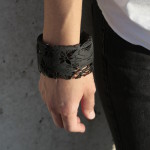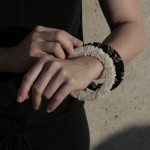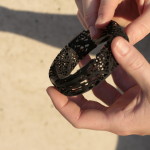by Veronika Meierhofer
ENGLISH
Veronika Meierhofer studied Industrial Design at the University of Art and Design Linz. She then went abroad in 2006 to gather international experience, first at the design studio of Ineke Hans in Arnhem (NL) and in 2007/08 at the Design Academy Eindhoven (NL). Since 2006 she has shown her work at group exhibitions, including at the Austrian Museum of Applied Arts in Vienna, at the Landestheater in Linz as well as at BA-CA Kunstforum and Semperdepot in Vienna. In 2009 she was awarded the talent prize of “sofresh.the jewellery award by Pierre Lang” for “Zwei – connecting jewellery”.
Zwei – two pieces of jewellery dedicated to the link between two people. A connecting pair is created by a pattern with two elements that interlock. The open areas of one are reflected in the surfaces of the other, forming positive and negative, like a key and its lock. The twelve pieces have been created with the help of computer-aided design (CAD) and produced using a special 3D printing process, resulting in a layer thick-ness of just 0,016 mm. This is the only way of realising the fine structure of the design, with some pieces taking up to eight hours to be printed.
Featured by CREATIVE REGION Linz & Upper Austria – http://www.creativeregion.org
DEUTSCH
Veronika Meierhofer studierte Industrial Design an der Hochschule für künstlerische und industrielle Gestaltung Linz. 2006 folgten Auslandserfahrungen im Designstudio Ineke Hans in Arnhem (NL) und 2007/08 an der Design Academy Eindhoven (NL). Seit 2006 präsentiert sie Arbeiten in Ausstellungsbeteiligungen, unter anderem im Museum für angewandte Kunst in Wien, am Landestheater in Linz, im BA-CA Kunstforum in Wien und im Semperdepot in Wien. 2009 gewann sie für „Zwei – connecting jewellery“ den Talentpreis des „sofresh.the jewellery award by Pierre Lang“.
Zwei – zwei Schmuckstücke, der Verbindung zweier Menschen gewidmet. Durch ein Muster, dessen zwei Elemente ineinandergreifen, entsteht ein verbindendes Paar. Die Aussparungen des einen spiegeln sich in den Flächen des anderen, bilden positiv und negativ, Schlüssel und Schloss. Die zwölf Schmuckstücke wurden mit Hilfe eines CAD (computer aided design)-Programms entworfen und über ein spezielles 3D-Druckverfahren hergestellt, mit welchem eine Schichtstärke von 0,016 mm erreicht wird. Nur so kann die feine Struktur des Musters umgesetzt werden. Einige Schmuckstücke brauchen bis zu acht Stunden um gedruckt zu werden.
Präsentiert von CREATIVE REGION Linz & Upper Austria – http://www.creativeregion.org
- Courtesy by Veronika Meierhofer
- Courtesy by Veronika Meierhofer
- Courtesy by Veronika Meierhofer
- Courtesy by Veronika Meierhofer




